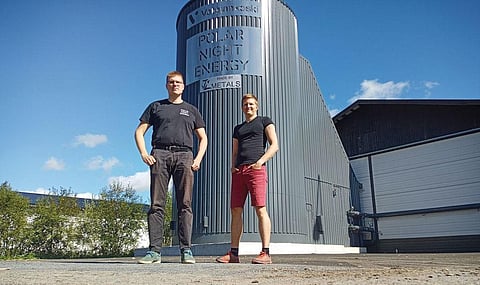

Finland has installed the world’s first sand battery that can store heat from renewable energy sources for months. The Finnish developers told Down To Earth that the battery, made of sand collected from construction sites, can solve the problem of round-the-year energy supply, a known limitation of renewable energy sources that can be harnessed intermittently.
This is a major breakthrough, as heat alone accounts for half of the world’s energy use, followed by transport (30 per cent) and electricity (20 per cent), as per intergovernmental organisation International Energy Agency (IEA). Currently, 80 per cent of the world’s energy comes from dirty fossil fuels.
The battery, a massive steel silo, 7 m tall and 4 m wide with 100 tonnes of sand, was installed in Finland’s Kankaanpää town in June 2022. It is connected to the town’s centralised heating network that keeps buildings and public water systems warm.
Owing to the cold temperature, all municipalities and cities in Finland have centralised heating networks, and 70 per cent of them use renewable sources, as per non-profit The Finnish District Heating and Cooling Association.
The renewable sector has several water-based storage systems that can heat buildings for short durations. But the Finnish researchers decided to replace water with sand because of its advantages.
Sand can be heated up to 600 degrees Celsius (°C), whereas water starts to boil at 100°C. It also has low heat conductivity, which reduces energy loss, says Ville Kivioja, lead scientist at Polar Night Energy, the company that has developed the battery.
The storage system has three main components: the sand silo, an electrical air heater and an air-to-water heat exchanger. For charging the sand silo, air is heated to 600°C in the electrical air heater.
The hot air is then circulated inside the silo using a heat-exchange pipe and blowers to raise the temperature of the sand at the silo’s core to 600°C. When the storage enters the discharging stage, the blowers are used to pump air into the pipe inside the sand silo. Once the air reaches 200°C, it is transferred to the air-to-water heat exchanger, where it is used to boil water. It is then sent to the heating network.
The storage system requires electricity at all times. It is needed to charge the battery, monitor the temperature during standby and run the blowers when the battery is used.
“For discharging 2 MW of heat, we roughly need 2 kW of electricity. Thus 1,000 times more power is discharged as heat than is used as electricity,” says Kivioja.
The installed battery can store 8 megawatt-hours (MWh) of energy and release heat at 0.1 MW — enough to provide heating and hot water for about 100 homes and a public swimming pool in Kankaanpää — for 80 hours on a full charge.
“We are developing a 200 MWh battery that can discharge heat at the rate of 2 MW (enough to meet the heating need of 100 Kankaanpää houses), with a discharge time of 100 hours,” says Kivioja.
The technology is promising, but its current capacity is not enough to meet the heating needs of an entire season, says Xiaoshu Lu, associate professor at the School of Technology and Innovations, Energy Technology at the University of Vaasa in Finland.
But Kivioja feels increasing the capacity is not a problem. “We can make 10 times bigger storages as well. But it is not reasonable to make an entire town to rely on just one storage system,” he says.
The Finnish company believes that the battery has a huge potential, even in countries without district heating networks. “In India, for instance, the battery provides big opportunities for process heating in industries, or heating municipal building complexes. It can be set up for any industry that requires more than 10,000 MWh heating in a year,” says Kivioja.
This was first published in the 16-28 February, 2023 print edition of Down To Earth